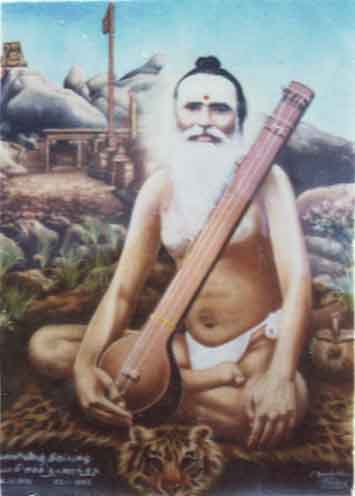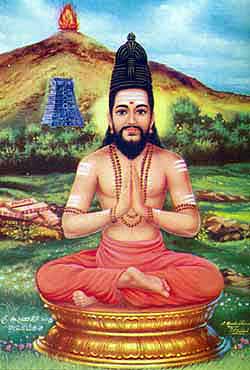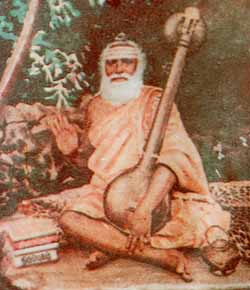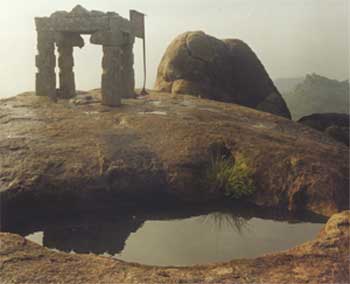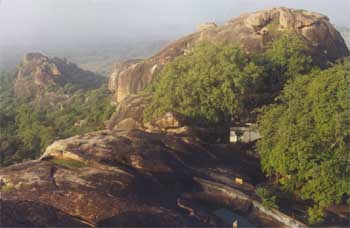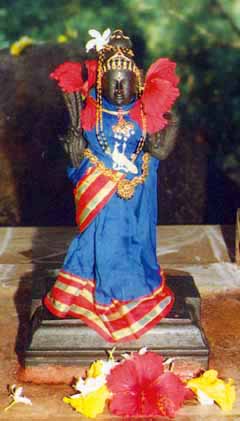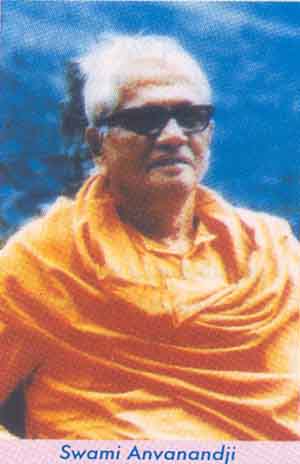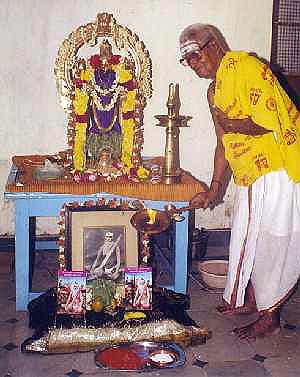
|
|||||||||||||||||
|
| |||||||||||||||||
My experience with Vallimalai Satchidananda Swamigal
P.S. KrishnanThere have been many narrations in print by various devotees, particularly, Śrī R. Kalyanasundaram (1957) and Swami Anvananda (1975) but few copies remain as they are long out of print. However it is my attempt to present information received directly from Swami as well some of the earliest episodes prior to 1948 narrated to me during the period of my contact with him. Under a divine order alone my first contact with the great soul Śrī Sacchidananda Swami occured at his beloveed Tiruttani on 31 December 1948 during the Step Festival initiated by Swami in the year 1917-18 (as I learned later from Swami in detail). Prior to that first encounter I had had a dream of Śrī Ramana Mahārshi of Tiruvannamalai leading me up a ladder, standing in an empty field. In the middle he disappeared and in his place a stalwart figure was leading me further up. I later recognised the stalwart figure as Śrī Vallimalai Swami as introduced by my friends who accompanied me enroute to Tiruvannamalai for darshan of Śrī Ramana. The dream and its symbolism became a key factor in my life. I had the great fortune to move closely with Swami for about two years from 1948 to 1950 when he attained samadhi at the ripe age of 80. At that time Swami needed help owing to old age. During his permanent stay at Chennai until 1950, my services were readily accepted by Swami and thereafter hardly a day passed without my meeting him till the end. During this period he helped me in various ways to practise spiritual sadhana.
At Palani, Swami was ordered by Lord Murukan to go to Tiruvannamalai, the birth place of Saint Arunagirinathar, where he could come in contact with the great saint Śrī Ramana Bhagawan. In Śrī Ramana, Swami saw the avatar of Sri Palani Āntavar (Lord Dandapani). Swami could learn properly the meaning and candam (cadence) of Tiruppukal. By the grace of Bhagawan, he mastered everything and rendered the songs in an emotional manner. However, by the order of Śrī Ramana Bhagwan, the search for a guru by Swami ended in meeting Śrī Sēśādri Swamigal at Tiruvannamalai, who has also confirmed that Tiruppukal songs are mahā mantrams, by reciting which all could be achieved. A parallel śloka from Śiva Manasīkapūja by Adi Śankara (4th śloka) was equalised by Swami by rendering a Tiruppukal song (Ācaikkor paktan).
Thenceforth Śrī Seśadri Swamigal directed Swami to go to Vallimalai, the famous abode of Lord Murukan and His Consort Śrī Valli, as explained in Kantap Purānam. Swami stayed at this place more than 38 years for his spiritual sādhanā as well as to bless devotees irrespective of cast or creed, young or old, rich or poor. Ultimately Swami had a rare experience at Vallimalai culminating in darśan of Lord Murukan and Śrī Valli. His attachment towards Devi Śrī Valli was very great. He used to tell me often that we should always praise Śrī Valli through Tiruppukal songs, so that She will point out to Lord Murukan at an opportune moment all our our needs, which He will fulfil readily as the request comes from his Consort. Swami used to find the grace of Śrī Valli in all and believed that Lord Murukan alone was Purusha and all the jīvas were only His consorts. (Jīva-Brahmā ikyam). In this connection Swami had complied with the help of Tiruppukal songs a medical with very great spiritual significance to the theme "Tiruppukal Jñana Saccidānanda Valli Caitam" (more details later). At Vallimalai he was a true illustrator of ideal bhakti. He never suffered for want of money or means of sustenance. But he always spent away then and there whatever money came to him and never retained a pie for morrow. He was very particular to feed the needy and believed that service to fellow beings was only true service. He never claimed to any power to work miracles or cure diseases or grant earthly requests. Always wanted to be a true and humble bhakta and to be called as "Valli Pāda Hridayan". Now let us ponder over Swami's philosophy, mission in life and how he could receive such rare sights including his selection of Tiruppukal songs for daily prayers, starting each day of the week in a particular order from Sunday to Saturday is not only estoric but based on principles of Yogaśāstra. Each day signifies a particular yoga cakra in the body and on Saturday envelop all the six leading to Sahasrara Cakra. It begins with salutation to Vinayaka, invocation to Lord Murukan, for abhiśekam, alankāram etc. It was given the name of Tiruppukal Parāyana Tavaneri Tirumurai - meaning that one could attain moksa by reciting (doing parāyanam). The invocation songs in Tiruppukal Parāyana Tavaneri Tirumurai clearly stress the importance of Āru Patai Vītu and invariably akin to six Adharams of Yoga Śāstra explained as follows: At the close of the second centuary AD a prominent devotee of Lord Murukan was Nakkīra Tēva Nāyanar, the author of Tirumurukārru Patai". He selected six temples situated in six specially sacred places and named them as Āru Patai Vītu. They are Tiruparankundram, Tiruchendur, Tiruvavinangudi, Swamimalai, Tiruttani, and Palamudircolai, i.e. Vallimalai. Those were the six holy places where Lord Murukan appeared in response to prayers offered by jñānis and saintly men on behalf of the devotees who seek His grace for eradication of their suffering as well for moksa. Further, Saint Arunagiri Nathar, in his Kandar Anubhuti (2) has dealt with six Addāracakra thus, Ullasa - Nirakula - Yoga - Vidha - Sallabha - Vinodhanan - (Nī Allayo - Ellam Ara Ennnai Yilantanala Collai Murukan Curapūpatiye), meaning "Oh Murukan! God of Devas, are you not (1) the joyous ever the carefee, (2) the unsorrowing, (3) the great yogi, (4) the doer of good to others, (5) possessed of kindly speech, and (6) the great marvel and surprise (translated by Swami Anvananda)?
Swami arranged very well to achieve moksha in a yogic way by reciting Tiruppukal songs for the above six abodes of Lord Murukan from Tirupparankunram to Vallimalai to awaken the eternal fire (Kundalini Śakti) in the solar plexus (Mulādhāra).
1) unai tinam tolutitan
2) Muntu Jamil malai koti koti.
3) Swanār manam kulirā
4) Enta phikayinum
5) Tarayit manutar Acinal -
6) Akarumai
7) Kumpakōnam ulayenkum maveya perumālō (whole world) (pp. 27-28) Swami discussed the importance of how he culled the Tiruvakuppu particularly expanded Vēlvakuppu to Vēl Maral and the importance of other vakuppus such as: (1) Kata Kaniyal Vakuppu, (2) Tēvedira Cankuvakuppu, (3) Vēl Vakuppu, (4) Sīrpāda Vakuppu, (5) Vēl Vangu Vakuppu (6) Vetici Kavalan Vakuppu. Regarding the efficacy of the above vakuppus, Swami had sufficient experience to prove as in each of which certain aspects of Lord Murukan are sung about, such as His Holy Feet, Vēl, His Consort Valli, Peacock vāhana, etc. Further, the combination of words in every vakuppu is very mystical and divine. Saint Arunagirinathar alone could render such songs which Swami with the blessings of Lord Murukan and Śrī Valli could popularise among the needy. Vel Maral (Maikkaval)The story goes as explained to me that one mantravādi who styled himself 'Triloka Murukan' played his powers on Swami at Vallimalai (in the year 1928) when Swami could not sing. Further by the grace of Lord Murukan he could remember Vēlvakuppu, which he rearranged by permutation in the 64 lines out of 16 lines of Vēlvakuppu and recited against the mantravādi. As a result the mantravādi's entire body got burning sensation and ultimately he surrendered to Swami with a promise that he would never use such powers in future . The efficacy of Vēlmaral for the benefit of suffering humanity has been proved. This has become a ready spiritual guide for getting over all sorts of difficulties including psychic ailments. Even today there are many who enjoy the benefit in reciting Vel Maral. Tēvenēndra Canku VakuppuSwami was very particular that this vakuppu has to be considered as the best approach to Devi Valli as Śodasaksari Mantra (16-syllabled mantra), described with Sanskrit words (Deva Bhāsā). One has to enjoy the result by reciting this vakuppu systematically. Tiruppukal Parāyana Tayaneri TirumuraiThe songs in this name has been compiled by Swami with all possible guides to attain mental peace as well spiritual progress to attain moksha (1996 publication is available with S.T. Sabha). Tiruppukal Jñāna Saccitānanta Valli CaritiramThis is entirely based on Jīva BrahmĀ Ikyam of Śrī Valli (all jīvātmas with Lord Murukan-Paramātma). At every step we are expected to confess our shortcomings and reach the final step at the feet of Lord Murukan on 31st December every year and return back home relieved from our mental distress by the grace of Lord Tiruttanikēsan. Vallimalai Swami had special attachment with Tanikēsan and His consorts. Swami attained samādhi on 22 November 1950 though Ajña Cakra (Tiruttani). Lord Murukan tested Valli in three ordeals, namely: (1) interest in family life; (2) interest in ornaments and other attractive materials like garments; (3) interest in other attractions in narration of purānam, palmistry, etc. None of the three interests had any impact in Her mind except that of Lord Murukan and ultimately Valli attained sanmargam (jīva-BrahmĀ ikyam).
Valli MalaiAt Vallimalai he inducted farmers, simple village youths, great scholars and well-known musicians all into his fold effortlessly as a way of stating that soul has no creed or cast. Special mention to be made in connection with a hunter girl of seven years, named as Valli by Swami, who had the most bewitching voice in rendering Tiruppukal songs. Similarly one blind destitute boy of eleven years could master all songs as educated by Swami, and named him an Kannappa Bhagavatar. During Swami's lifetime I had the rare opportunity to receive and own and play his four-stringed instrument called jati vadyam, a very rare instrument invented by Swami and as a replacement of eratara which he had earlier (a single-stringed instrument). The four stringed one has a thrilling effect when Swami played during Tiruppukal recitals. On many occasions as he related to me, this instrument vanished from His hand at Vallimalai and Śrī Valli Herself played with it for few minutes. As such this instrument has been nick-named by Swami as Pongi vadyam (played with help of two sticks one thin and another thick.) Last but not least, an interesting incident happened at Vallimalai during Swami's stay. Early one day three people -- a renowned mendicant, a leading lawer, and an industrialist -- were curious to meet Swami in connection with a hearsay that Swami had the ability to convert iron into gold. As usual they were received at Vallimalai and given a warm reception over a cup of coffee, which they never expected to get at the top of Vallimalai. As they started questioning Swami about their doubts, with a smile on his face Swami read out Tiruppukal songs narrated by Saint Arunagirinathar in his Cittu Vakuppu, detailing items to be procured and used properly as directed therein. If any of the items are unavailable, the attempt will be only a waste of money and time. Instead one can spare the time (in search of such items) in concentrating the feet of Lord Murukan who is ready to bless and give anything. This upadesa had a marvellous effect upon the lives of those visitors who left Vallimalai fully charged with the grace of Valli-Murukan and Swami. One among them, Swami Anvānanda, was ordained by Valli to construct a temple for her at Chennai in the year 1954 as Śrī Vaishnavi temple.
Just a few months before Swami attained samadhi he made his spiritual force enshrined in the image of Śrī Vaishnavi Devi as named by him early on 12.1.1950 with kara sparsam and singing Tiruppukal (Tēvēntira Canku Vakuppu). Subsequently Devi had Her domain very prominently at Tirumullaivayal near Chennai, attracting very many devotees from for and wide. Devi fulfils the love and affections that Swami was pouring on the devotees even after His lifetime. A few months before He left the world, perhaps had a duty to attend the samadhi of Śrī Ramana Bhagawan about which Swami could visualise on 4 April 1950, ten days before the event. On 14.4.1950 Śrī Ramana Bhagwan left the world as known to Swami and confirmed that Śrī Ramana is still among us as a bright star among other stars in the sky to bless us. In October 1950, I visited Vallimali for the first time and returned after a short stay. The significance of this trip occurred to me later. While in Madras, Swami had arranged for a six day Skanda Sasti festival during 10th November 1950 at Thambu Chetty Street, which I participated in. On the fifth day, while Swami was performing sangīta upanyāsam on Śrī Valli Sanmargam, there was a sudden break in the upanyāsam. Swami could not proceed further and retired. After a few hours, he could recollect and told us that he had darsan of Lord Murukan while he was conducting the festival. On the 12th day (22nd November 1950) he attained samadhi at about 4 a.m., when a spurt of blood came out between his eyebrows (ajña cakra). With the help of Śrī Swami Anvananda, in whom Swami had full faith as his torchbearer, I took the body to Vallimalai and interned it in the cave which he had previously prepared for his samadhi. My visit to Ramanasramam after Mahārshi's samadhi helped me to make similar arrangements at Vallimalai. Śrī Mauna Guruswami had kept the whole place neat and clean, in a fitting manner for the internment of the body. He continued to live in the asram and maintained the samadhi from that date onwards for seventeen years. In conclusion, all my eloquence fails to express the greatness of Vallimalai Swami and the experiences I had with him for the short period of two years. For the trivial services I rendered to him, I find he continues to shower his grace on me since that time. Pazhayanur Subramania Krishnan Iyer, b. 1912, is President and Founder of the Śrī Vallimalai Swami Satchidananda Tiruppugazh Sabha and Trustee of Śrī Vaishnavi Shrine, Tirumullaivayil. He was personally associated with such saints as Ramana Maharshi and Śrī Vallimalai Swami Satchidananda. For more information, visit the Valli Malai official website Note : Tiruppukal Parāyana
Index of research articles on Skanda-Murukan |
